New Zealand’s isolation from other landmasses and the absence of native land mammals have led to the evolution of a diverse array of flightless birds and unique endemic species. The country’s fascinating wildlife includes various captivating bird species and marine life that make it a true treasure trove for nature enthusiasts and visitors.
Key Takeaways: New Zealand’s Unique Native Animals
- The kiwi is perhaps the most iconic of all New Zealand’s native animals. It is a flightless bird with hair-like feathers, a long beak, and a keen sense of smell. Several kiwi species exist, and they are nocturnal, ground-dwelling birds.
- The kākāpō is a critically endangered, nocturnal, flightless parrot. It is known for its docile nature and owl-like appearance, and it is the world’s heaviest parrot.
- The tūī is a unique and highly vocal songbird with a distinctive white throat tuft. They are excellent mimics and have a wide range of sounds in their repertoire.
- One of the smallest and rarest dolphins in the world, Hector’s dolphin is found only in New Zealand’s coastal waters. It has a distinctive rounded dorsal fin.
One of the most well-known flightless birds in New Zealand is the kiwi, a national symbol and a bird that represents the country’s identity. There are several species of kiwi, each with its unique characteristics and behaviors. Another remarkable flightless bird is the kea, the alpine parrot, known for its intelligence and curiosity.
New Zealand is also home to some incredible living fossils, such as the tuatara, a reptile species that dates back to the dinosaur era. These fascinating creatures are often referred to as “living dinosaurs” due to their ancient lineage and unique evolutionary history.
The marine life in New Zealand’s waters is equally captivating. The country’s coastal areas are inhabited by a variety of marine animals, including the world’s smallest dolphins, Hector’s dolphins. These adorable creatures are a delight to observe in their natural habitat. Additionally, the country’s waters are frequented by charming furry seals, adding to the diverse range of wildlife experiences that New Zealand offers.
The country’s commitment to conservation and protecting its unique biodiversity has contributed to the preservation of these remarkable species. For anyone with an interest in wildlife and natural wonders, a visit to New Zealand is sure to be an unforgettable experience, as it offers a chance to encounter some of the world’s most extraordinary and unique animals and birds.
Kiwi Bird
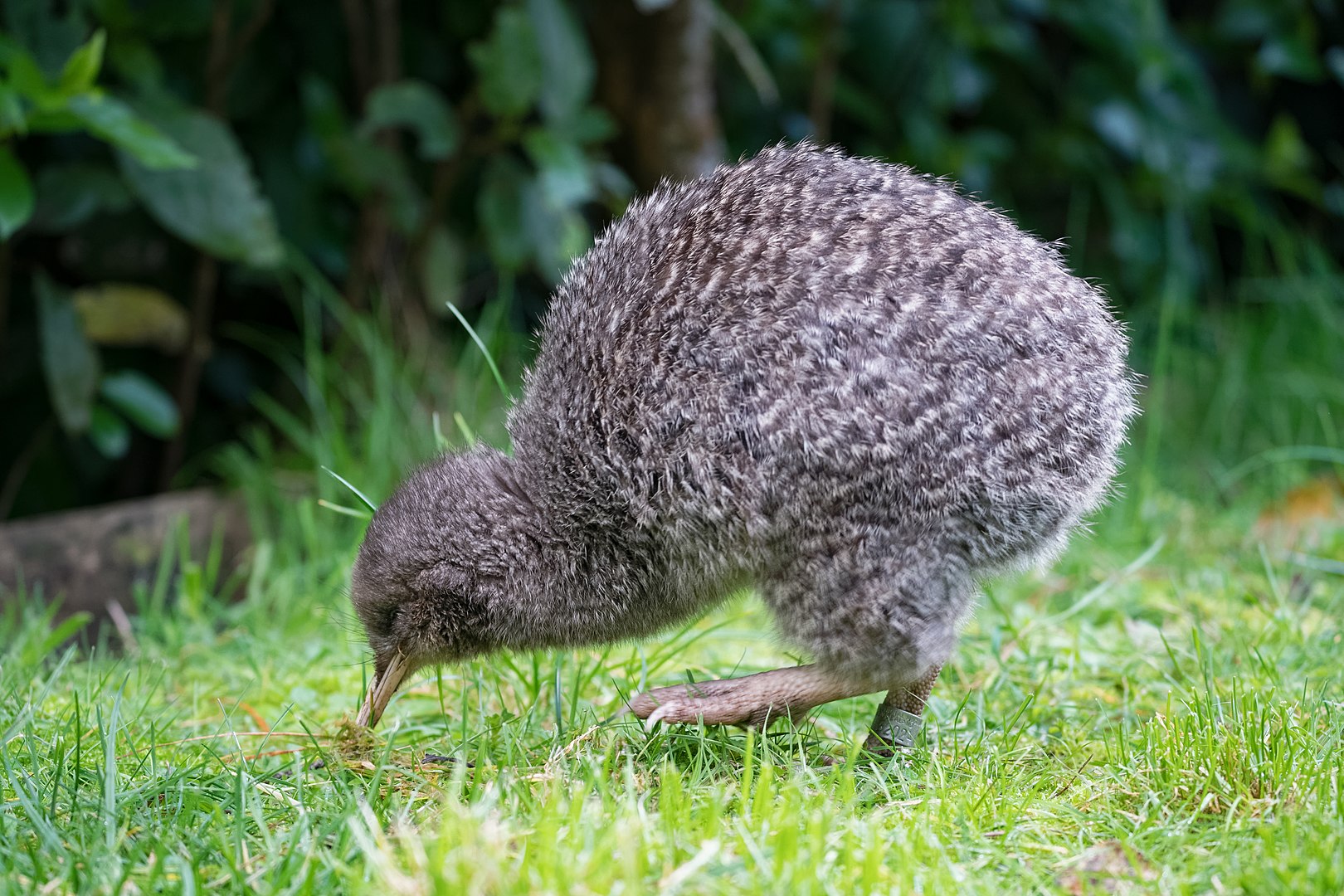
The Kiwi bird is indeed one of New Zealand’s most beloved and iconic animals. While they are highly cherished, encountering them in urban areas or wandering around public places is a rare occurrence due to their nocturnal nature and preference for forested habitats.
Kiwi birds are endemic to New Zealand, meaning they are found nowhere else in the world. They primarily inhabit dense forests, where they can find shelter and food. Being nocturnal, they are most active during the night, using their keen sense of smell to forage for food.
One of the most distinctive features of the Kiwi bird is its long beak with nostrils at the tip. This unique adaptation allows them to probe the forest floor and sniff out their prey, including insects, worms, and other small invertebrates. They are omnivorous and have a varied diet, which can include fruits, seeds, and even some types of small vertebrates.
Kiwi birds are highly adapted to their forested environment. They have strong legs and claws, which they use for digging and probing in search of food. Their feathers are unique, resembling coarser hair than typical bird feathers, and they are relatively soft to the touch.
Due to their elusive and nocturnal behavior, spotting a Kiwi bird in the wild can be a challenging yet rewarding experience for nature enthusiasts visiting New Zealand. However, given their vulnerable status and the efforts of conservation organizations, there are opportunities to see Kiwi birds in specialized sanctuaries and wildlife reserves that focus on protecting these cherished and extraordinary creatures.
New Zealand Lesser Short-Tailed Bat (Mystacina tuberculata)
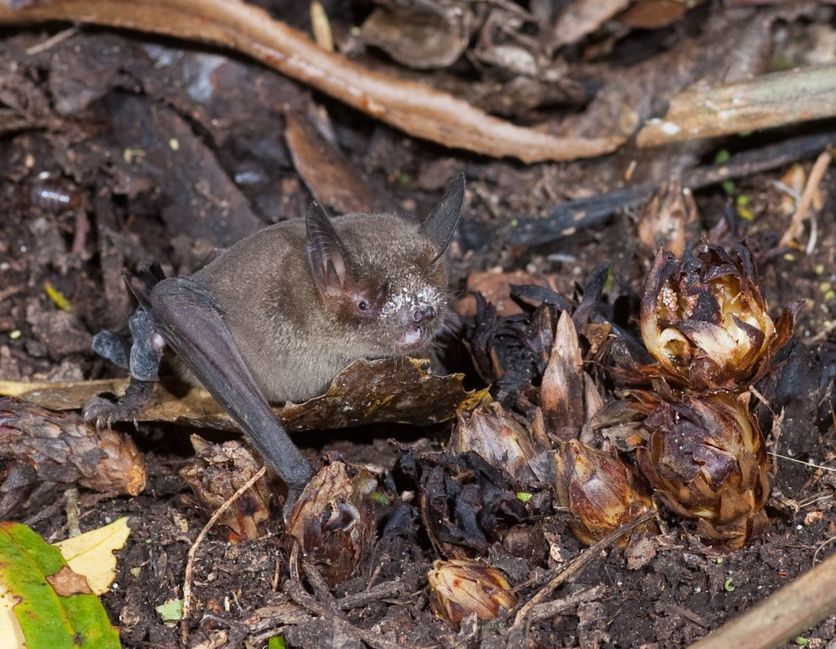
“Pekapeka” is the local name for the native bat species in New Zealand, also known as the New Zealand long-tailed bat (Chalinolobus tuberculatus). It is a unique mammal species, as it is the only native land mammal found in the country.
The New Zealand long-tailed bat is indeed endangered and faces various threats to its survival. Habitat loss, predation by introduced mammalian predators (such as rats, cats, and stoats), and human disturbance are some of the factors contributing to its decline. As a result, the bat’s population has significantly reduced, and it is now only found in a few regions of New Zealand.
Efforts are being made to conserve and protect the remaining populations of these bats. Conservation organizations and the New Zealand government are working together to implement conservation measures, restore their habitats, and manage the threats posed by invasive predators. Additionally, public awareness campaigns and research initiatives are ongoing to better understand the ecology and behavior of these unique and endangered bats.
Preserving the New Zealand long-tailed bat is essential not only for the species’ survival but also for maintaining the ecological balance and biodiversity of New Zealand’s natural ecosystems. As the only native mammal in the country, their conservation is a critical part of New Zealand’s commitment to protecting its unique and irreplaceable wildlife.
Hector’s Dolphin (Cephalorhynchus hectori)
Hector’s dolphins, scientifically known as Cephalorhynchus hectori, are small and unique cetaceans found exclusively in the waters around New Zealand. They are one of the smallest and most endangered dolphin species in the world.
Hector’s dolphins have a distinct appearance, characterized by their rounded dorsal fins and distinctive coloration, which includes a striking black and gray pattern on their bodies. They are known for their playful and inquisitive behavior; they are often seen leaping and riding the bow waves of boats.
Due to their limited distribution and small population size, Hector’s dolphins are highly vulnerable to various threats, such as fishing gear entanglement, habitat degradation, pollution, and vessel traffic. These factors have contributed to their status as an endangered species.
Conservation efforts are crucial for the survival of Hector’s dolphins. The New Zealand government and various conservation organizations are working to implement measures to protect their habitats, regulate fishing practices, and raise public awareness about the importance of conserving this unique and precious species.
Given their limited range and the ongoing threats they face, encountering Hector’s dolphins in the wild is a special and rare experience. For tourists and nature enthusiasts visiting New Zealand, observing these charming and endangered dolphins in their natural environment can be a true highlight and a testament to the importance of preserving and protecting the country’s rich marine biodiversity.
Kea Parrot (Nestor notabilis)
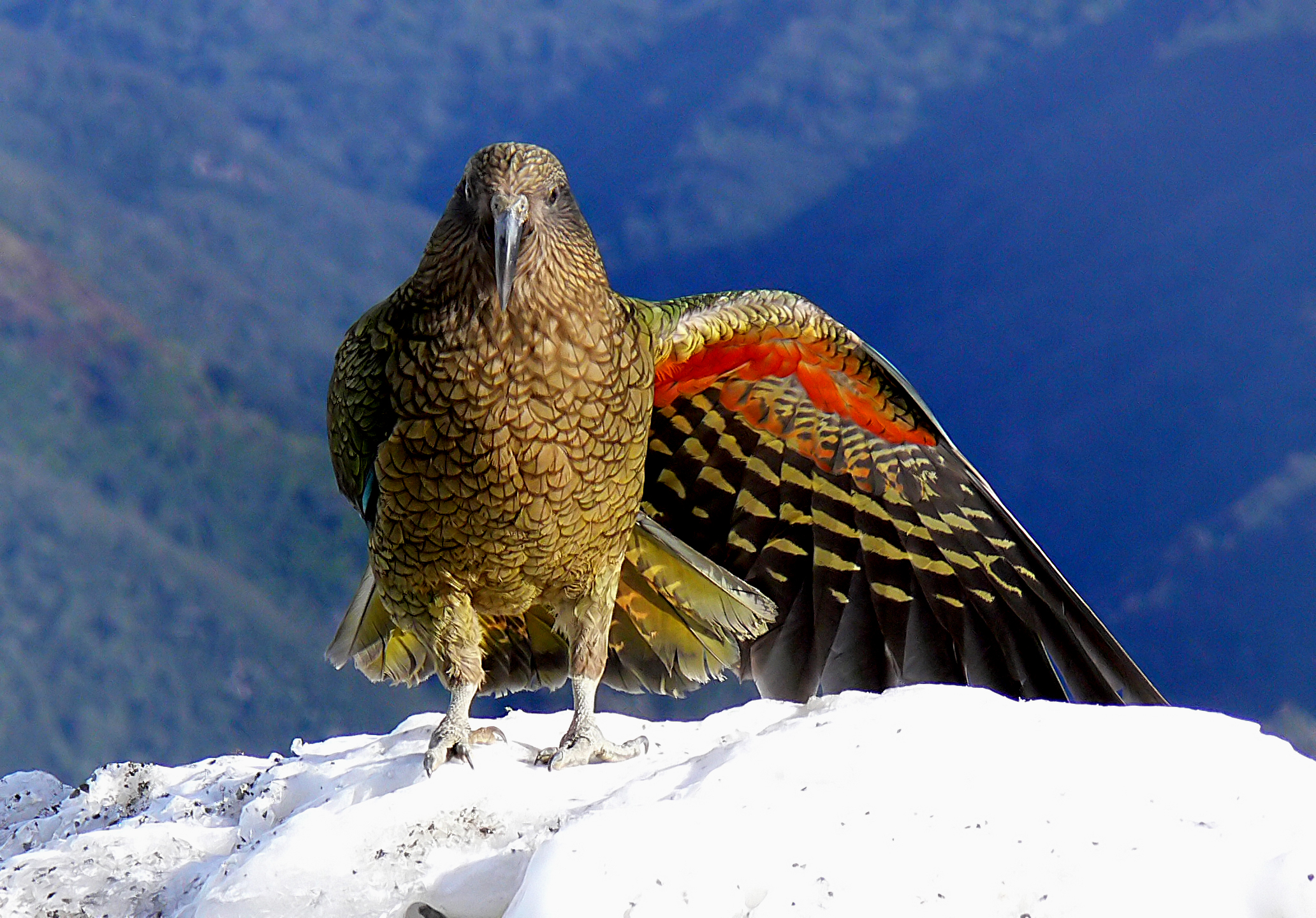
The kea (Nestor notabilis) is a remarkable and unique parrot species found only in New Zealand. It is renowned for its ability to inhabit high-altitude mountainous regions, making it the world’s only alpine parrot.
Keas are predominantly found in specific areas on the South Island of New Zealand, such as Arthur’s Pass National Park and Fiordland National Park, which offer the ideal alpine habitats they prefer. However, they can also be spotted in various other high-mountainous regions on the South Island.
These parrots are truly captivating, not only for their beauty but also for their exceptional intelligence and natural curiosity. They are known for their playful and mischievous behavior, which can sometimes include approaching and interacting with humans and vehicles. Keas have been observed to investigate cars and dismantle parts, such as rubber trims and windshield wipers, using their strong beaks.
While their inquisitiveness and playful antics can be entertaining for tourists and observers, it is essential to strike a balance between enjoying their presence and ensuring their well-being and conservation. Keas, like many native species in New Zealand, are protected, and their conservation is vital to maintaining the country’s unique biodiversity.
Given their remarkable characteristics and playful behavior, keas have become an attraction for tourists and vehicle owners, making them a subject of both fascination and occasional challenges in certain areas of New Zealand. As with all wildlife encounters, it is crucial to respect and observe keas from a distance to ensure their natural behaviors and habitats are preserved for generations to come.
Hamilton’s Frog (Leiopelma hamiltoni)

Hamilton’s frog (Leiopelma hamiltoni), also known as the Stephens Island frog, is a critically endangered species of frog that is native to Stephens Island, New Zealand. Sadly, recent population assessments have indicated that only around 300 individuals of this species remain in the wild, making them one of the most endangered frog species in the world.
The New Zealand Ministry of Conservation has placed Hamilton’s frogs under strict protection due to their critical status in order to ensure their survival and preservation. Conservation efforts focus on habitat restoration, predator control, and captive breeding programs to boost their populations.
One fascinating characteristic of Hamilton’s frogs is their inability to produce the typical “ribbit” sound commonly associated with frogs. Unlike most other frog species, they lack vocal sacs and do not possess the necessary anatomical structures to croak. Instead, they communicate through other means, such as visual displays and physical movements.
The unique traits and critical status of Hamilton’s frogs make them a significant conservation priority for New Zealand. Preserving these small and intriguing creatures is not only vital for the health of their island ecosystem but also for the preservation of New Zealand’s unique and precious biodiversity. Efforts to protect and conserve Hamilton’s frogs serve as an essential reminder of the importance of safeguarding the world’s endangered species and their delicate habitats.
Yellow-Eyed Penguin (Megadyptes antipodes)
The yellow-eyed penguin (Megadyptes antipodes) is a unique and endemic species of penguin found in New Zealand. It is one of the six different penguin species that inhabit the country, making it a significant part of New Zealand’s diverse and fascinating wildlife.
The yellow-eyed penguin is known for its striking appearance, characterized by its distinct yellow eyes, which set it apart from other penguin species. These penguins are mainly found in specific regions of New Zealand, including the Banks Peninsula and Stewart Island, located in the southeast of the country. Additionally, they can also be observed on surrounding islands.
As an endemic species, the yellow-eyed penguin holds a special place in New Zealand’s natural heritage. However, like many other penguin species, it faces several conservation challenges, including habitat loss, human disturbance, and threats from introduced predators. Consequently, the yellow-eyed penguin is classified as an endangered species.
Conservation efforts are crucial to protect the habitat and population of the yellow-eyed penguin. Various initiatives by conservation organizations and government agencies aim to preserve their nesting areas, control predators, and raise public awareness about the importance of safeguarding these unique and precious creatures.
Observing the yellow-eyed penguin in its natural environment is a rewarding experience for tourists and wildlife enthusiasts visiting New Zealand. It serves as a reminder of the country’s commitment to preserving its rich biodiversity and the need to cherish and protect its extraordinary endemic species for future generations to enjoy.
Chevron Skink (Oligosoma homalonotum)
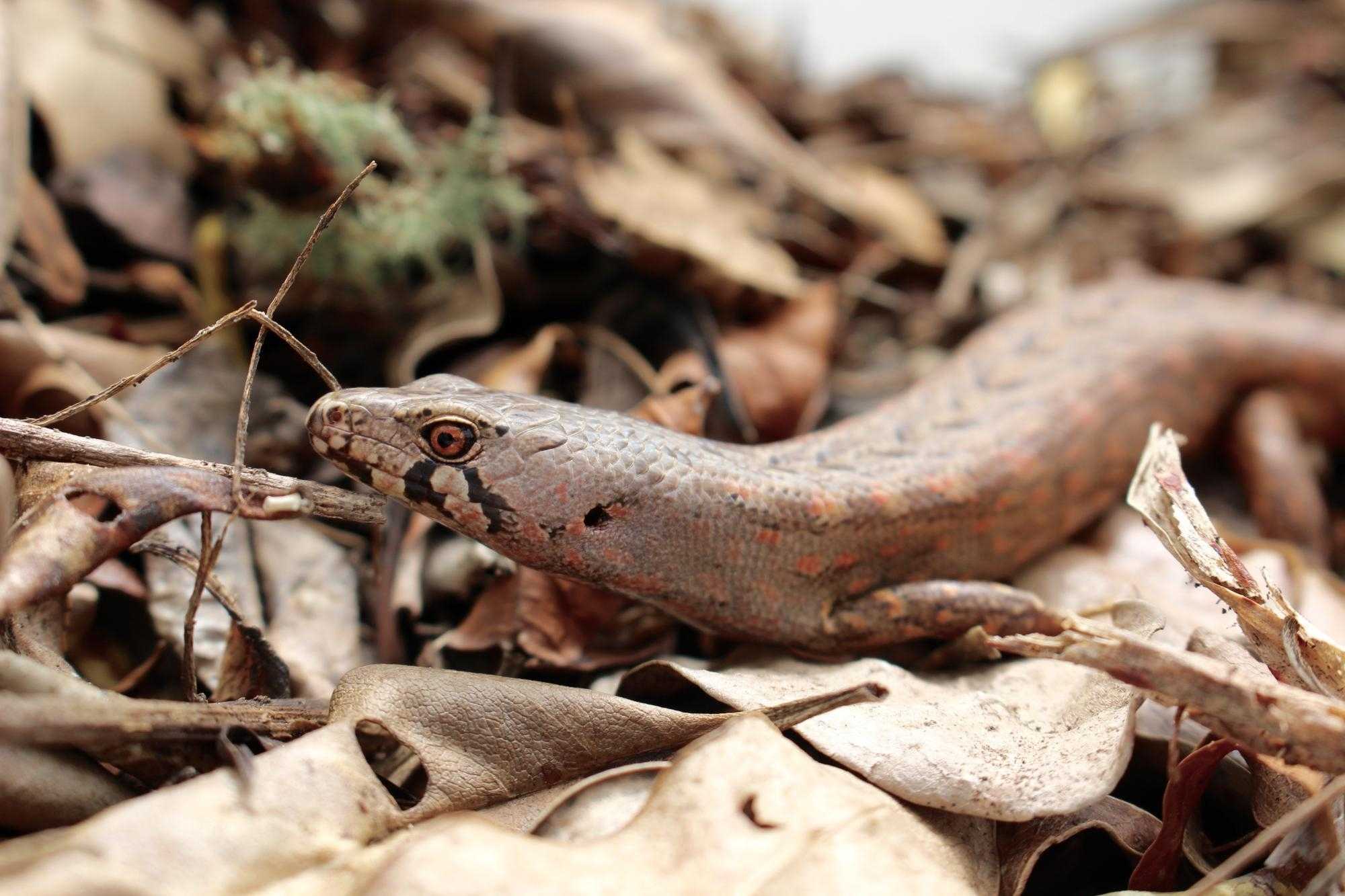
The Chesterfield skink is an endemic lizard species found exclusively on Great Barrier Island and Little Barrier Island, both located off the coast of New Zealand.
These skinks are known for their secretive nature, which makes them challenging to spot in the wild. They are the longest lizards in New Zealand, measuring around 30 centimeters in length. Due to their restricted range and limited population, the Chesterfield skink is considered a vulnerable species, making their conservation a priority.
The estimated population of these skinks is relatively small, with around 500 individuals believed to exist in the wild. Given their rarity and vulnerability, conservation efforts are essential to protect their habitats and ensure their survival in the long term.
In captivity, the Chesterfield skink can live up to 20 years, making it a valuable subject for research and conservation studies. The information gained from studying these lizards in captivity can provide valuable insights into their behavior, ecology, and potential threats they face in the wild.
Preserving and protecting unique and endemic species like the Chesterfield skink is vital to maintaining the ecological balance and biodiversity of New Zealand’s islands. Their presence reminds us of the importance of conservation efforts to safeguard these extraordinary creatures and their habitats for future generations to appreciate and cherish.
Kākāpō
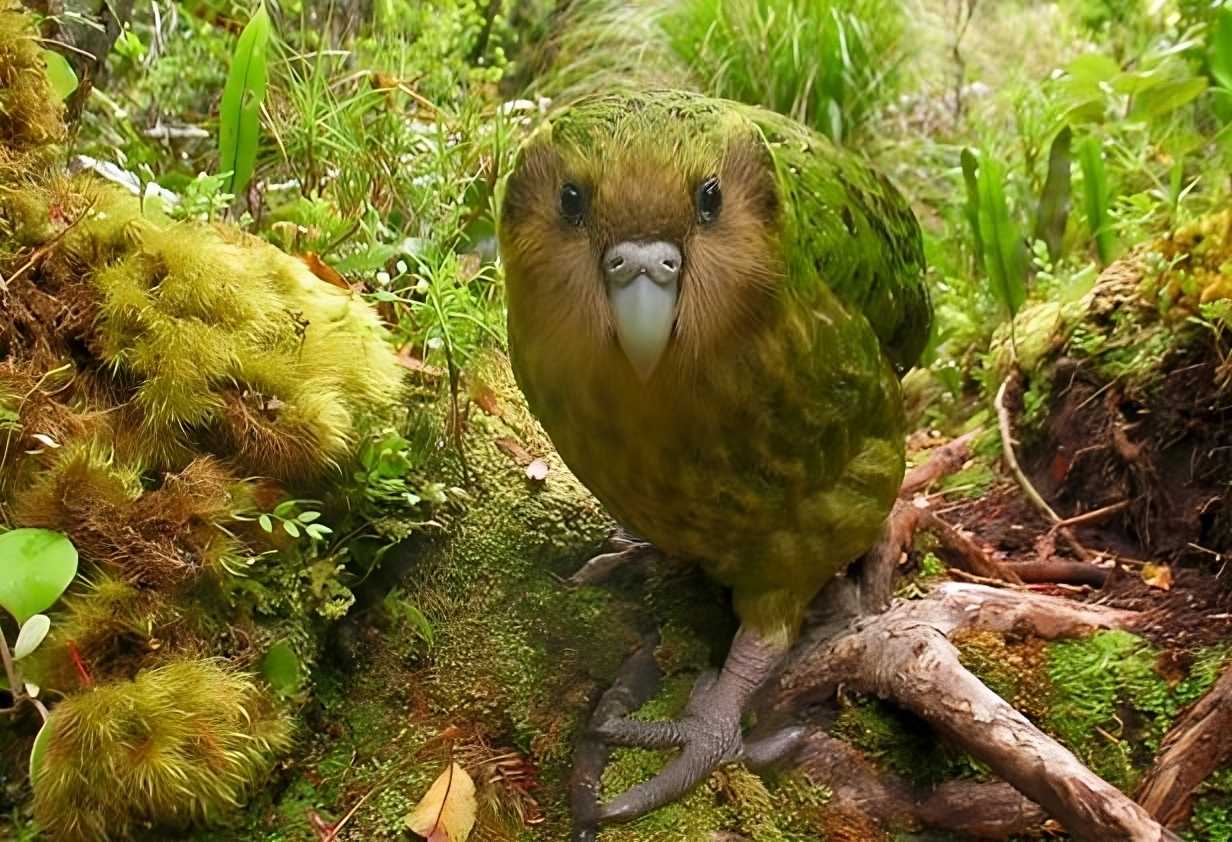
The Kākāpō (Strigops habroptilus) is a unique and fascinating flightless parrot native to New Zealand. It holds several remarkable distinctions, including being the world’s heaviest parrot and the only flightless parrot species. The Kakapo’s herbivorous diet sets it apart from most other parrot species, which are primarily omnivorous.
One of the Kakapo’s most distinctive features is its mottled patterns, which provide excellent camouflage in its natural environment. This camouflage helps the bird blend into its surroundings and avoid detection by potential predators.
Sadly, the Kakapo is currently listed as critically endangered, primarily due to centuries of human influence and the introduction of invasive species. Historically, the Kakapo faced hunting pressure from New Zealand’s native Maori people, who hunted the bird for its meat and feathers. However, the most devastating impact occurred with the arrival of European settlers, who brought various predators like cats, dogs, and rats to the islands. With no natural defenses against these introduced predators, the flightless Kakapo had no way to escape, leading to a drastic decline in their numbers.
Conservation initiatives are currently ongoing to safeguard and preserve the remaining Kakapo population. Conservationists have moved some of the survivors to predator-free islands in New Zealand, where they are under close observation and protection. The goal of this relocation approach is to establish safe areas where Kakapo can breed and grow without fear of predators.
Conservationists, researchers, and the New Zealand government are working tirelessly to ensure the survival of this unique and precious species. The Kakapo serves as a powerful reminder of the importance of protecting and preserving the world’s biodiversity, especially for species that are on the brink of extinction. Efforts to save the Kakapo are a testament to humanity’s dedication to safeguarding the natural wonders that make our planet so diverse and remarkable.
Little Blue Penguin (Eudyptula minor)
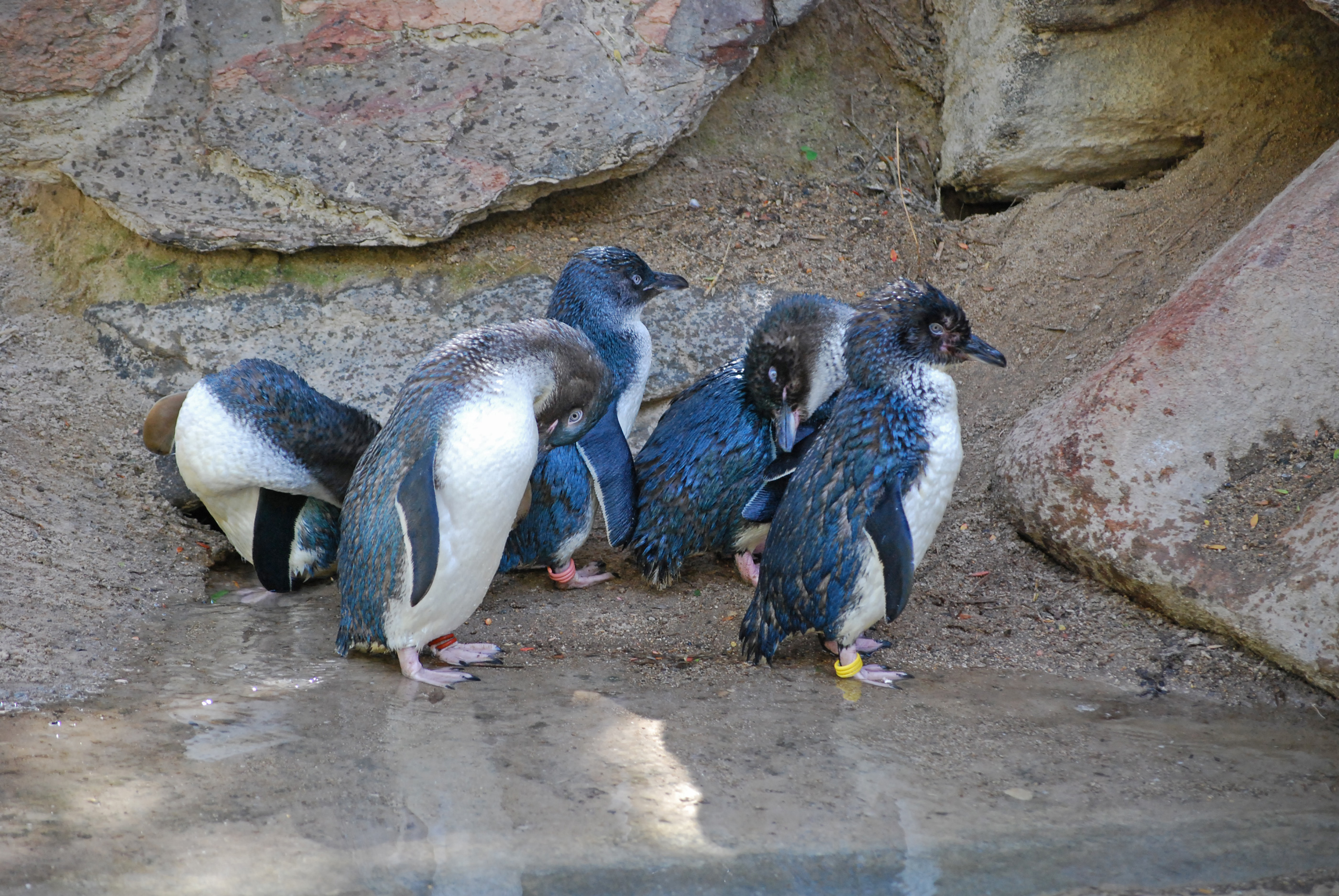
The Little Blue Penguin (Eudyptula minor), also known as the Little Penguin, is indeed a commonly found species in New Zealand. Despite being found in other countries like Australia and Chile, it holds a special place in New Zealand’s wildlife.
As its name suggests, the Little Blue Penguin is one of the smallest penguin species globally, with an average size of approximately 43 centimeters. This diminutive size makes them particularly endearing and captivating to observe in their natural habitat.
These charming penguins are highly adaptable and are known for their distinctive blue feathers, which add to their unique appearance. They have a delightful, quirky waddle on land and are equally adept swimmers in the water, where they feed on small fish, squid, and crustaceans.
The Little Blue Penguin is often spotted near the coast and on offshore islands throughout New Zealand, making it a familiar sight for both locals and visitors alike. They typically nest in burrows or other sheltered places on land and return to the same nesting site year after year.
Like many other penguin species, the Little Blue Penguin faces various conservation challenges, including habitat loss, pollution, and human disturbance. Conservation efforts are crucial to protecting their nesting sites and ensuring that these delightful penguins continue to thrive in their natural environment.
Tourists and wildlife enthusiasts visiting New Zealand have the opportunity to witness the captivating behavior of these charming Little Blue Penguins, making it a memorable experience and a chance to appreciate the unique diversity of New Zealand’s wildlife.
New Zealand fur seal (Arctocephalus forsteri)
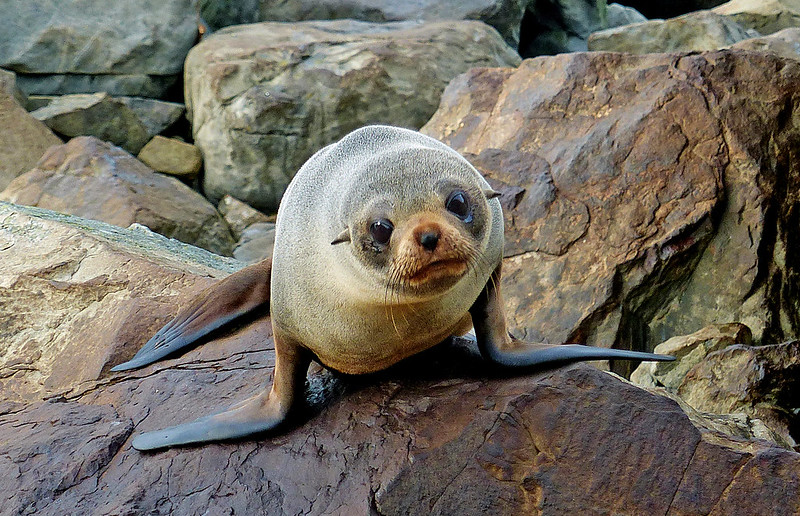
New Zealand fur seals (Arctocephalus forsteri) were once hunted for their fur, leading to a significant decline in their population. However, their numbers have rebounded since they gained protection, and they are now considered a protected species in New Zealand.
These charismatic marine mammals are abundant along the coasts of the South Island, particularly in areas such as Kaikoura, Catlins, and Fiordland National Park. They are highly adaptable and can be found in various coastal habitats, including rocky shorelines and sandy beaches.
During the winter months, some New Zealand fur seals venture northward to the Cook Strait, seeking food and suitable breeding sites. While they generally stay close to the shore and rocky outcrops, their curious and exploratory nature can lead them to venture into more urban areas.
It is not uncommon to hear reports of New Zealand fur seals being spotted in unexpected locations, such as people’s backyards or even city streets. The lookout for food or a secure resting place might be the driving force behind their wanderings. While these encounters can be surprising and delightful for residents and visitors, it is essential to remember that these are wild animals and should be given space and respect.
As a protected species, it is crucial to ensure that their natural habitats and breeding areas are preserved and conserved. New Zealand fur seals play a vital role in the coastal ecosystem, and their presence is a significant part of the country’s rich biodiversity.
Conservation efforts, public awareness, and responsible wildlife viewing practices contribute to the continued protection and well-being of the New Zealand fur seals, allowing future generations to enjoy their delightful presence along the country’s beautiful coasts.
Tuatara (Sphenodon punctatus)
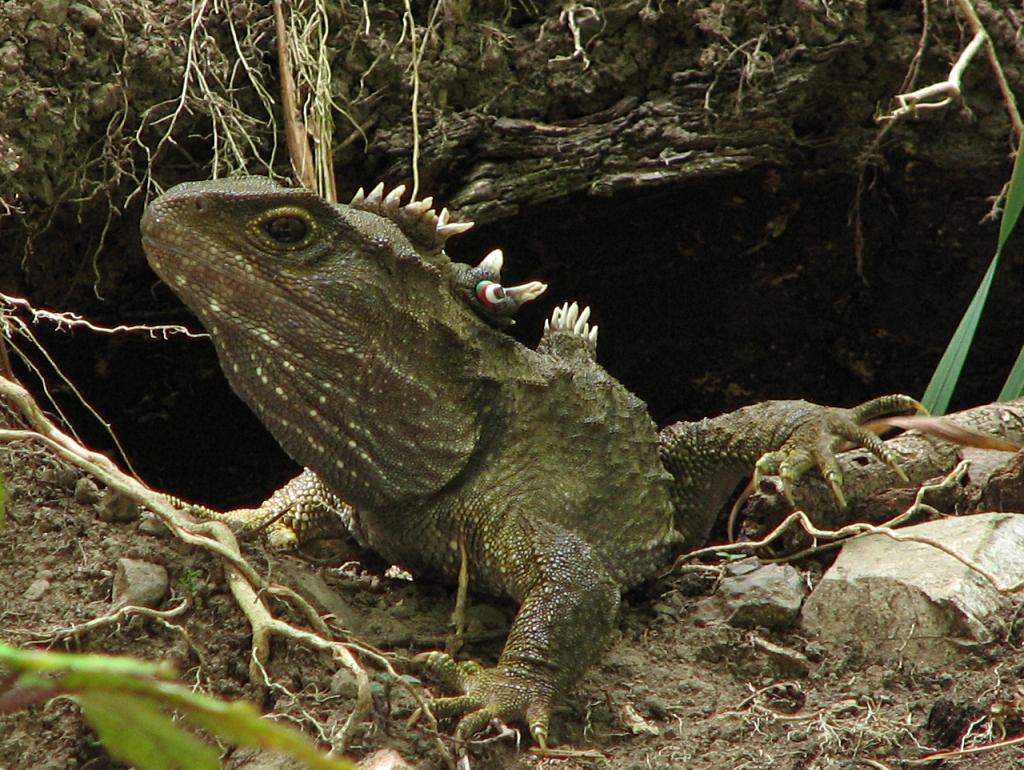
The tuatara (Sphenodon punctatus) is indeed a unique reptile that has survived from the age of dinosaurs, making it a living relic and earning it the nickname “living dinosaur.” This fascinating creature is native to New Zealand and holds a special place in the country’s biodiversity.
One of the most intriguing features of tuatara is the presence of a “third eye” on top of their heads, known as the parietal eye. This eye is not a functional visual organ like their two regular eyes, but it has light-detecting cells called photoreceptors. The parietal eye helps tuatara sense changes in light intensity, enabling them to be aware of their surroundings and the time of day.
While it doesn’t provide detailed images, the parietal eye is believed to play a role in thermoregulation and orientation. Tuatara are ectothermic, meaning they rely on external sources of heat to regulate their body temperature. By sensing changes in light, they can determine the direction of the sun and position themselves to bask in sunlight, which helps them maintain their body temperature.
Tuatara are primarily found on offshore islands in New Zealand and have been the subject of intensive conservation efforts due to their endangered status. Introduced predators and habitat loss have posed significant threats to their populations in the wild.
As a result, numerous conservation centers and wildlife sanctuaries across New Zealand work diligently to protect and preserve tuatara populations. These facilities provide safe environments for tuatara breeding, hatching, and research. They also play a crucial role in public education, raising awareness about tuatara conservation and the importance of protecting New Zealand’s unique wildlife.
The tuatara’s survival from prehistoric times to the present day makes it an incredible living testament to the rich evolutionary history of New Zealand and a remarkable species worth protecting for future generations.
Saddleback (Philesturnus carunculatus)

The medium-sized bird is the Saddleback (Philesturnus carunculatus), also known as the New Zealand Saddleback. It is a native bird species found in New Zealand, particularly on pest-free islands and in animal conservation areas where they are better protected from introduced predators.
The Saddleback is a member of the family Callaeidae, which includes several other unique bird species native to New Zealand. Like the New Zealand robin, the Saddleback is known for its distinctive coloration and behavior.
Adult male Saddlebacks exhibit striking black and red plumage, with a black head, back, and wings and a bright red-orange “saddle” on their lower back, which gives them their name. This coloration is most pronounced during the breeding season and serves as a way for males to attract mates and establish territory.
On the other hand, females have more subdued coloration, with brownish and grayish feathers in some parts of their bodies. This sexual dimorphism is common in many bird species, where males and females exhibit different color patterns.
The Saddleback is known for its inquisitive and sociable behavior, often approaching humans and displaying curiosity in their surroundings. They are skilled insectivores and feed on a variety of invertebrates found in the forest, including insects, spiders, and worms.
As with many other native bird species in New Zealand, the Saddleback faced significant threats from introduced predators such as rats, stoats, and cats. These introduced species have had a detrimental impact on the native bird populations, leading to declines and extinctions of several species.
Conservation efforts, such as pest control and the establishment of predator-free islands and protected areas, have been essential in ensuring the survival and recovery of the Saddleback and other native bird species. These efforts provide a safe and suitable habitat for the Saddleback to thrive and contribute to the unique biodiversity of New Zealand.
Māui Dolphin (Cephalorhynchus hectori maui)
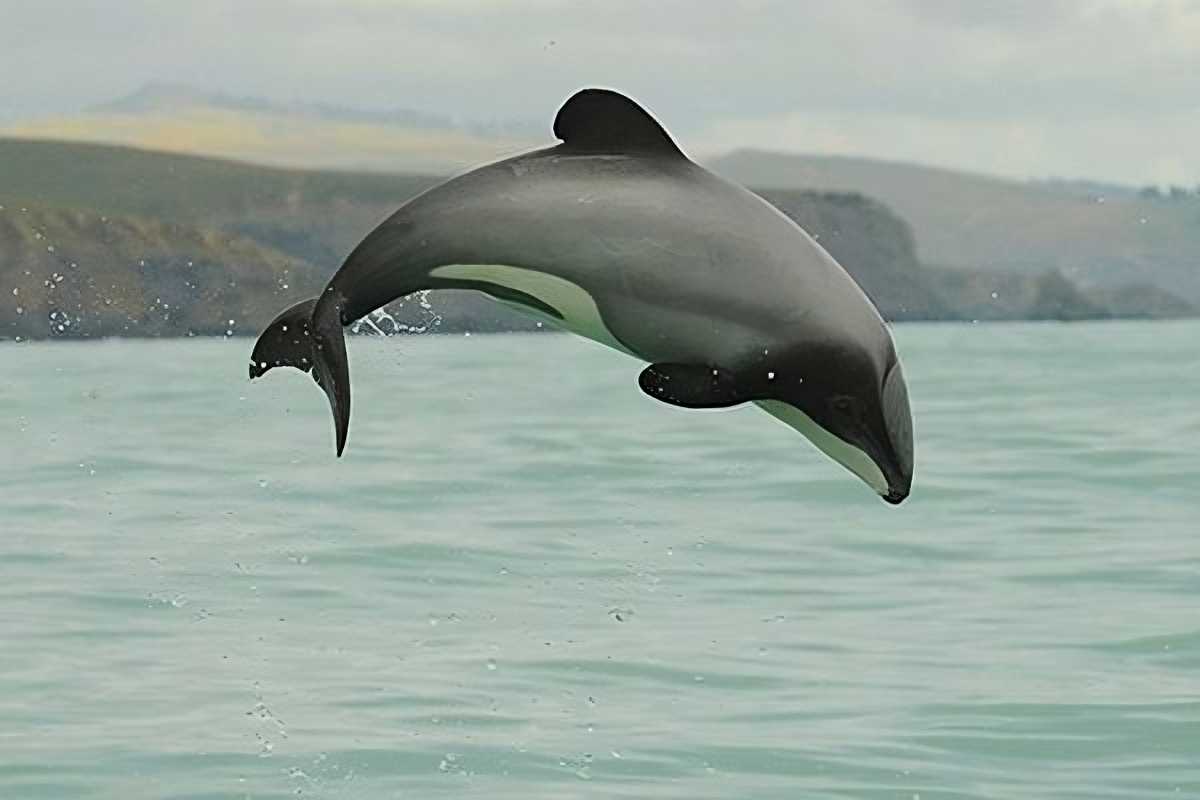
The Maui dolphin (Cephalorhynchus hectori maui) is a subspecies of the Hector’s dolphin (Cephalorhynchus hectori) and is found exclusively in the waters of New Zealand. It is one of the smallest and rarest dolphin species in the world.
The Maui dolphin is critically endangered, and its population is severely threatened. According to estimates, there are only around 50 individuals remaining, making it one of the most endangered marine mammal species globally.
The primary threats to the Maui dolphin’s survival are human-related activities, such as fishing and boat traffic. Due to their small size and limited distribution in coastal areas, they are particularly vulnerable to becoming entangled in fishing gear, such as gillnets and trawl nets. These accidental captures, known as bycatch, have had a significant impact on the Maui dolphin population.
In response to the critical status of the species, conservation efforts are being undertaken to protect the Maui dolphin and its habitat. Various measures, such as fishing restrictions and the establishment of marine protected areas, have been implemented to reduce the risk of bycatch and provide safe zones for the dolphins.
Conservation organizations and governmental agencies in New Zealand are working together to monitor and protect the Maui dolphin population. Public awareness campaigns have also been launched to educate local communities and visitors about the importance of preserving this unique and endangered species.
Despite these efforts, the survival of the Maui dolphin remains precarious, and ongoing conservation actions are essential to ensure its long-term survival. Protecting this rare and special marine mammal is crucial not only for its ecological role but also for the overall health and biodiversity of New Zealand’s coastal ecosystems.
Takahē (Porphyrio hochstetteri)
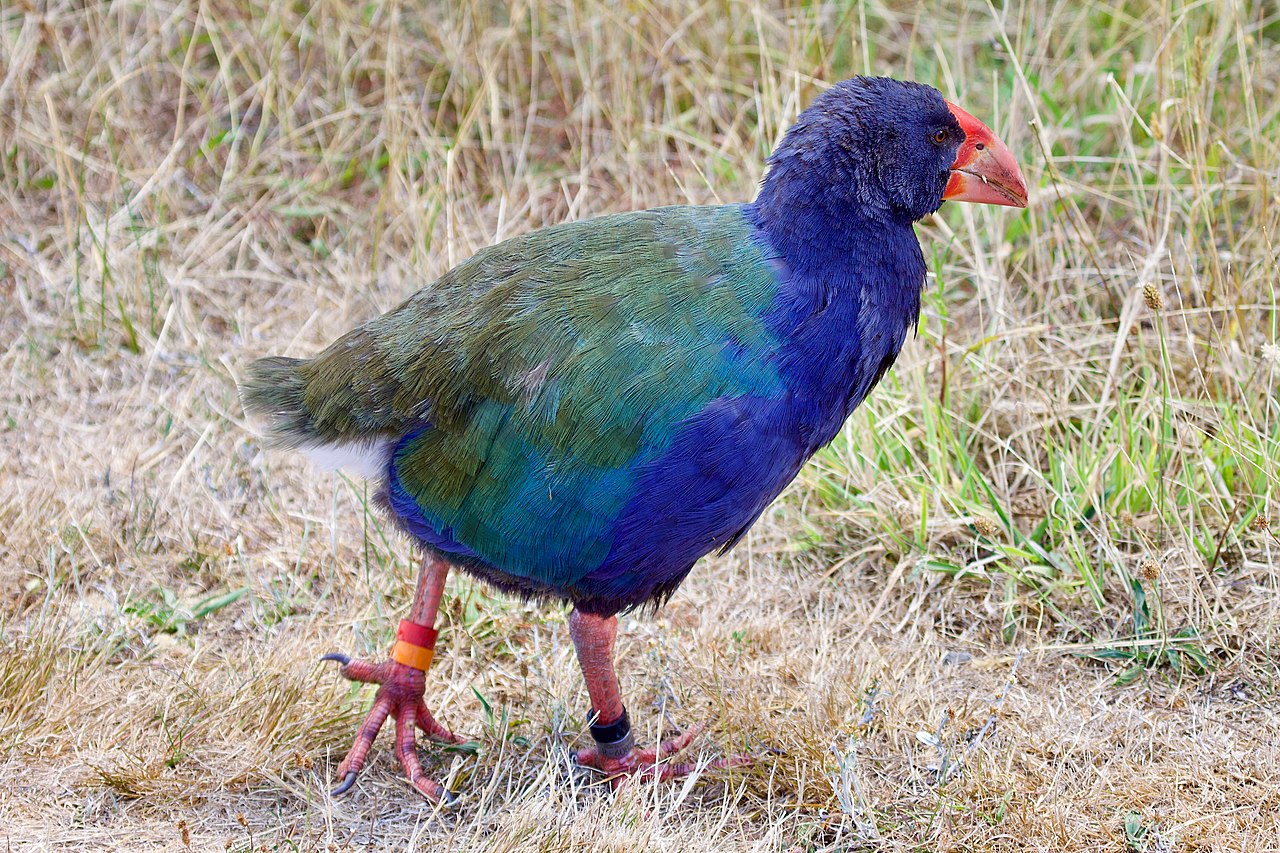
The takahe (Porphyrio hochstetteri) is a remarkable bird species native to New Zealand. Once considered extinct, it was rediscovered in the Murchison Mountains of Fiordland in 1948. The rediscovery of the takahe was a momentous event for conservationists, as it had been believed to have been extinct for over 50 years before that.
The takahe is the largest species of rail bird in the world. It is a flightless bird that has adapted to the unique environment of New Zealand, which lacks terrestrial mammalian predators except for some bats and marine species. This lack of predators has allowed certain bird species in New Zealand to evolve without the need for flight.
With abundant food resources and a relatively mild climate, some bird species, including the takahe, have evolved to increase in size and weight significantly. This phenomenon is known as “island gigantism” and is observed in various bird species on isolated islands where predation pressure is low.
The takahe is an herbivorous bird, primarily feeding on a variety of plants, including grasses, roots, and shoots. Its large size and robust build make it well-adapted for foraging on the forest floor and in grasslands.
Despite the rediscovery of the takahe, it remains a critically endangered species. Conservation efforts have been ongoing to protect and preserve their habitats, prevent predation from introduced species, and establish breeding programs to increase their population. Organizations like the New Zealand Department of Conservation and various wildlife sanctuaries work tirelessly to safeguard the future of the takahe and other unique bird species found in New Zealand.
Tūī (Prosthemadera novaeseelandiae)
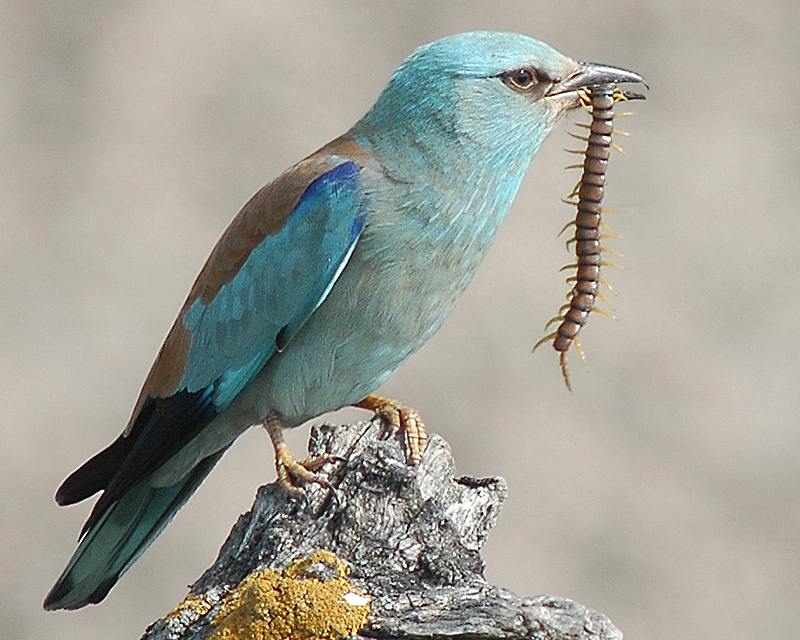
The tui (Prosthemadera novaeseelandiae) is a fascinating and distinctive bird species native to New Zealand. Its melodious and diverse range of sounds, often described as “robotic” due to their mechanical and complex nature, make it a prominent and recognizable bird in New Zealand’s forests.
The tui’s plumage is predominantly black, but it exhibits striking iridescent colors on its head and throat, which can change depending on the angle of light, giving it a beautiful sheen. One of its most distinguishing features is the presence of two long white tufts of feathers under its neck, called “poi.” These white feathers add to the tui’s unique appearance and help differentiate it from other bird species in the region.
Tui are highly adaptable and can be found in various forested habitats throughout New Zealand, including native forests, coastal areas, urban gardens, and even suburban areas with adequate greenery. They are nectar-feeders and play a crucial role in pollinating native flowering plants, such as kowhai and flax.
Besides nectar, tui have an omnivorous diet and also feed on fruits, insects, and occasionally small lizards. They have specialized tongues that allow them to extract nectar from flowers efficiently.
The tui’s vocal abilities are exceptional, and they are known for their songs, chattering, and mimicking abilities. They can mimic various sounds in their environment, including the calls of other birds and even human-made noises like ringing phones or car alarms.
Tui are also territorial birds and actively defend their feeding and breeding areas from other tui and bird species. Their loud and varied calls serve as part of their territorial display, helping establish and maintain their presence in their chosen territory.
The presence of tui is highly valued in New Zealand, and their beautiful songs add a delightful soundtrack to the country’s natural environment. They are protected under New Zealand’s wildlife conservation laws, and efforts are made to preserve their habitats and ensure their continued presence in the country’s forests and urban green spaces.
New Zealand Bellbird (Anthornis melanura)
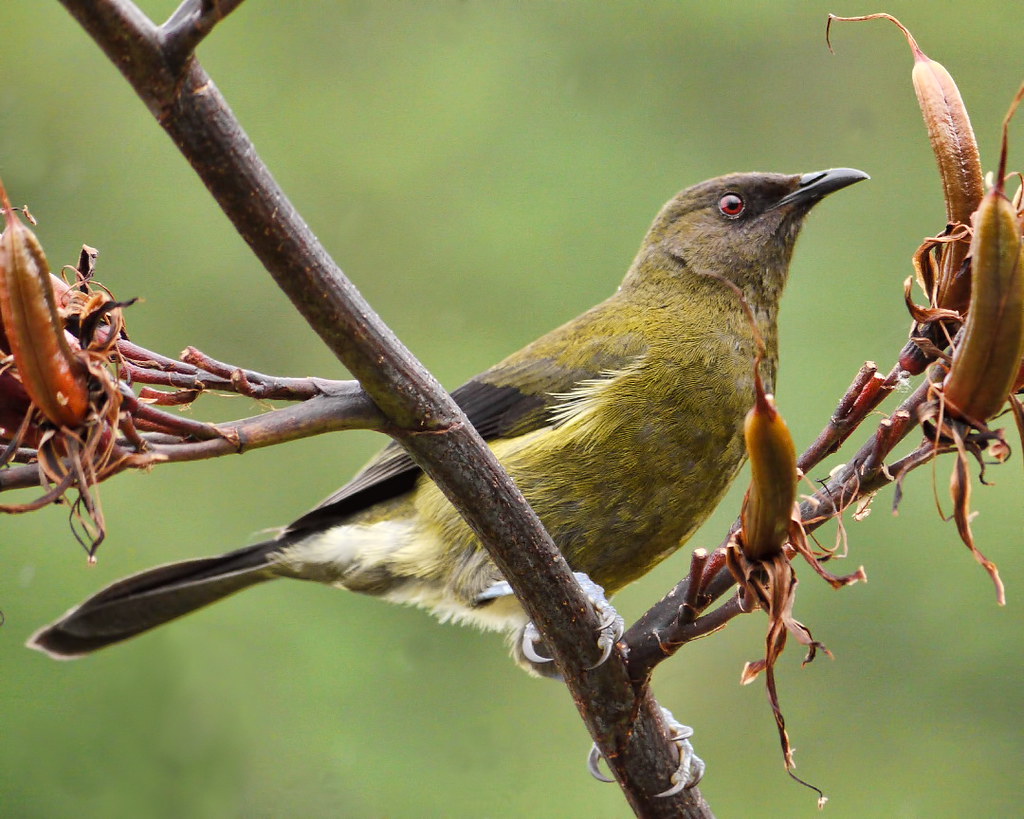
The bellbird (Anthornis melanura), also known as the korimako in Māori, is indeed a bird species that shares similarities with the tui in terms of its melodious and tuneful song. It is one of New Zealand’s native birds and is endemic to the country, meaning it is found nowhere else in the world.
The bellbird is a small to medium-sized bird with distinctive green plumage, which allows it to blend well with the forested areas it inhabits. It is known for its vibrant coloration and its iridescent feathers, which can shimmer in various hues of green when caught in the sunlight.
Like the tui, the bellbird is a nectar-feeder and plays a significant role in pollination within New Zealand’s native forests. It feeds on nectar from various flowering plants, helping these plants reproduce and thrive. In addition to nectar, bellbirds also consume insects, fruits, and berries, making their diet varied and adaptable to different seasons and resources.
The bellbird’s song is truly enchanting, and its melodious notes resonate throughout New Zealand’s forests. The song is often described as rich, clear, and flute-like, with a beautiful melody that captivates those who hear it. Captain James Cook, the renowned explorer, indeed wrote about these birds’ exquisite song during his exploration of New Zealand.
While the bellbird and tui share some similarities in their songs, each species has its own unique nuances and variations, allowing keen listeners to distinguish between the two.
Unfortunately, like many of New Zealand’s native bird species, the bellbird has faced challenges due to habitat loss and introduced predators, which have impacted their populations. However, various conservation efforts are in place to protect and preserve these delightful songbirds, ensuring that future generations can continue to enjoy their beautiful melodies in New Zealand’s forests.
Kererū (Hemiphaga novaeseelandiae) or New Zealand Pigeon
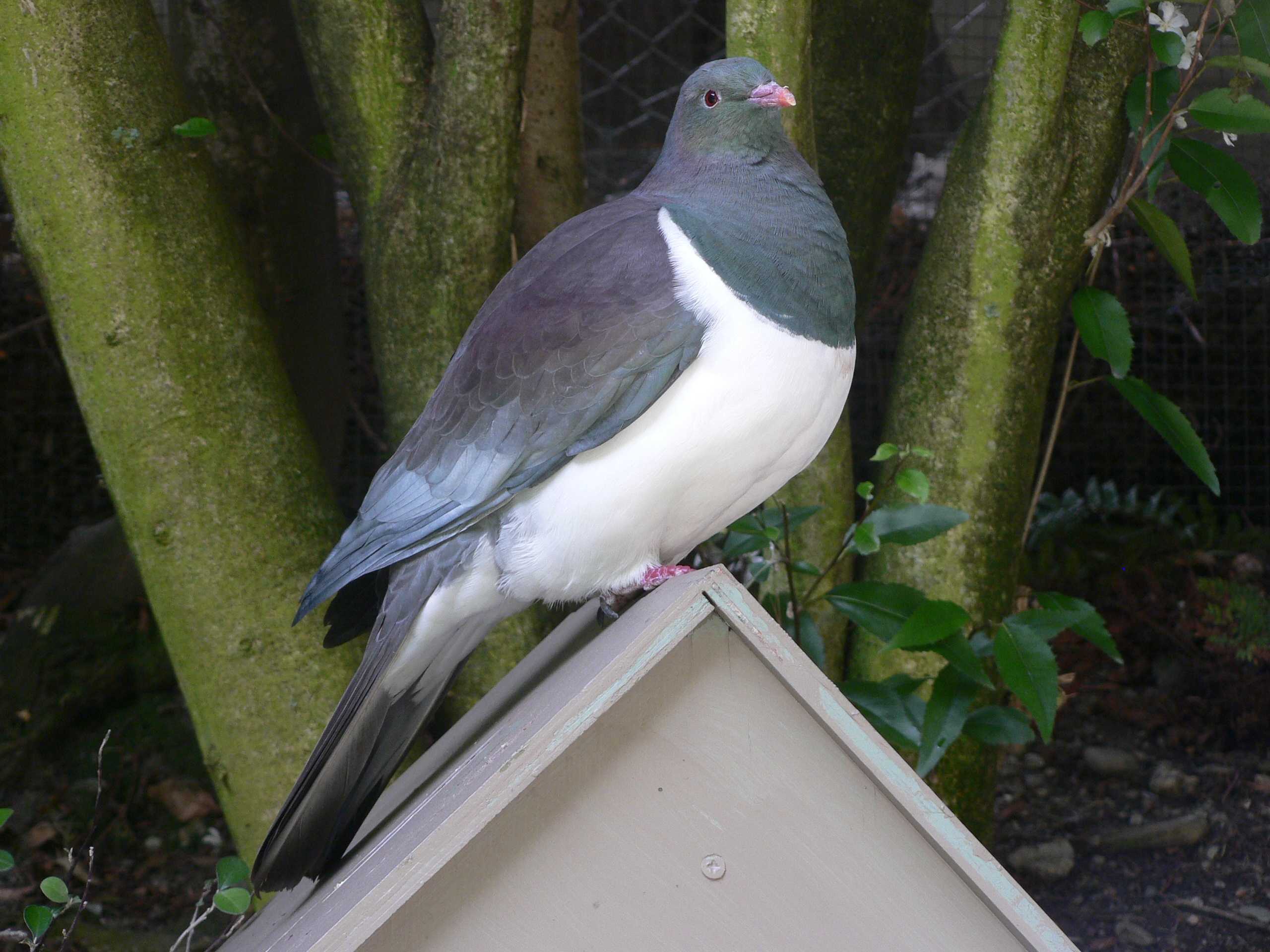
The New Zealand wood pigeon, known as kereru in Māori, is indeed a unique and stunning bird species native to New Zealand. Also referred to as the native pigeon or kukupa, it is a significant and charismatic bird in New Zealand’s native forests.
The kereru is a large pigeon, much larger than the common street pigeons often seen in urban areas. Its size and striking green plumage make it easily distinguishable when perched or flying among the forest branches. The vibrant green color of its feathers, combined with flashes of iridescent purple and white, creates a truly magnificent appearance.
As a member of the Columbidae family, the Kereru is the only pigeon species that is native to New Zealand. Its unique characteristics and role in the ecosystem have made it an important cultural symbol for the Māori people and a cherished bird among birdwatchers and nature enthusiasts.
The kereru plays a vital role in New Zealand’s native forests as a seed disperser. It feeds on a variety of fruits, especially those from native trees like the karaka, tawa, and puriri. After consuming the fruits, the kereru passes the seeds intact through its digestive system, helping to disperse them to different locations. This process aids in the regeneration and propagation of native plant species.
Historically, the kereru was an essential food source for the Māori indigenous people. The bird’s abundance and large size made it a valuable resource for sustenance. However, with the arrival of European settlers, hunting, habitat loss, and introduced predators took a toll on the Kereru population, leading to its decline in certain regions.
The kereru is currently a protected species, and numerous conservation initiatives are in place to ensure its survival. It is a cherished bird among New Zealanders and a symbol of the country’s unique biodiversity. The kereru’s presence in New Zealand’s forests is a reminder of the importance of preserving and protecting native ecosystems and the species that depend on them.
Morepork (Ninox novaeseelandiae)
The morepork, also known as ruru in Māori, is a distinctive and iconic owl species native to New Zealand. It is the only native owl found on the islands of New Zealand and is well-known for its haunting calls, which are commonly heard in forested areas during the night.
The morepork is a medium-sized owl with a striking appearance. It has large, dark eyes, a round face, and distinctive brown and white plumage that provides excellent camouflage in its forested habitat. The name “morepork” is an onomatopoeic reference to its call, which sounds like the phrase “more-pork” repeated in a rhythmic pattern.
As a nocturnal species, the morepork is most active at night, when it hunts for its primary food sources, such as insects, small mammals, birds, and sometimes even other small owls. Its keen sense of hearing and excellent night vision help it locate and capture its prey in the darkness.
The morepork’s calls are an iconic sound of New Zealand’s native forests, and they play a significant role in Māori culture and folklore. In Māori mythology, the morepork is associated with the spirit world and is sometimes considered a harbinger of death or an omen. The bird’s distinctive calls at night have inspired many stories and legends.
In addition to New Zealand, morepork can also be found in the neighboring Australian state of Tasmania. However, its range is much more extensive in New Zealand, where it is a well-adapted and unique member of the native fauna.
Like many native species in New Zealand, the morepork faces threats from habitat loss, predation by introduced species, and other human-induced factors. Conservation efforts are in place to protect the morepork and its native forest habitat, ensuring that its haunting calls continue to be heard in New Zealand’s wild places for generations to come.
New Zealand Falcon
The New Zealand falcon, known as kārearea in Māori, is a native and endemic species of falcon found in New Zealand. While they are not very common in terms of their overall numbers, they are highly valued for their significance as a unique and important part of New Zealand’s native wildlife.
Kārearea are powerful and agile birds of prey, well adapted to hunting in the diverse landscapes of New Zealand, which include forests, grasslands, and alpine regions. They are skilled hunters, preying on a variety of animals, including birds, small mammals, and insects.
In the past, kārearea were threatened by habitat loss and persecution, but efforts have been made to protect and conserve these magnificent birds. Raptor bird sanctuaries and other conservation areas have been established to provide safe habitats for the falcons and help their populations thrive.
Kārearea are highly valued in Māori culture and are regarded as a taonga, or treasure. They hold significant spiritual and cultural importance for Māori, with their agility, speed, and keen hunting abilities often being associated with positive traits and admired qualities.
The New Zealand falcon is also recognized as the country’s only remaining endemic bird of prey. Its survival and conservation are important for maintaining the ecological balance and cultural heritage of New Zealand’s unique and precious natural environment. Efforts to protect and preserve the kārearea reflect the country’s commitment to safeguarding its native species and promoting biodiversity conservation.
New Zealand Sea Lion
The New Zealand sea lion (Phocarctos hookeri) is indeed one of the most endangered sea lion species in the world and is unique to New Zealand. They are primarily found on the subantarctic Auckland Islands and Campbell Island, as well as the mainland of New Zealand, particularly around the Otago Peninsula near Dunedin and in the Catlins region.
Adult male New Zealand sea lions can reach lengths of up to 2 meters (around 6.5 feet) and weigh around 190 kilograms (approximately 420 pounds), making them one of the largest species of sea lions. Adult females are generally smaller, with lengths averaging around 1.8 meters (about 5.9 feet) and weights around 110 kilograms (approximately 240 pounds).
The gestation period of New Zealand sea lions is indeed quite long, lasting for about 12 months. This extended period is typical for sea lions and other pinnipeds (seals and sea lions) and allows for the development of the growing pup inside the female’s womb.
Despite their size, New Zealand sea lions are considered to be nearly defenseless on land, especially against human disturbances and introduced predators. Historically, they were heavily hunted for their fur and oil, which severely depleted their populations. Today, their main threats include human disturbance on breeding beaches, bycatch in fishing nets, and disease outbreaks. These factors have contributed to their critically endangered status and the need for ongoing conservation efforts to protect and preserve this unique and vulnerable species.
Conservation measures, including protected areas and breeding sites, have been established to help the recovery of the New Zealand sea lion population. These conservation efforts aim to protect their habitats, reduce human impacts, and raise awareness about the importance of preserving this iconic and rare marine mammal for future generations.
New Zealand Fantail (Rhipidura fuliginosa)
The New Zealand fantail, also known as piwakawaka, is a charming and well-known bird native to New Zealand. Its name “fantail” is derived from its distinctive fan-shaped tail, which it often spreads out in a beautiful display. The tail is an important feature that allows the bird to perform its agile aerial acrobatics.
New Zealand fantails are indeed widespread throughout the country and are commonly found in a variety of habitats, including forests, gardens, parks, and even urban areas. They are known for their friendly and curious nature, and they often approach humans closely, especially in forested areas where they may even follow people walking along tracks. This behavior has earned them a reputation for being friendly and inquisitive birds.
Their agile flight and graceful tail movements make them a delight to watch as they dart and flutter through the air, catching insects on the wing. The fan-shaped tail is used not only for aerial maneuvers but also as a form of communication. When they flick their tails open and closed, it is believed to be a way of signaling and expressing emotions, such as curiosity or alertness.
In Māori mythology, the piwakawaka is considered a messenger of the spirit world, and its appearance is believed to bring messages from the ancestors. It is also said that the bird’s distinctive tail shape came about as a result of a mythological encounter with Maui, a revered figure in Māori culture.
The New Zealand fantail is a cherished and iconic bird in New Zealand, and its presence adds to the beauty and charm of the country’s diverse and unique wildlife. Their adaptability to various environments and their willingness to interact with people have made them a beloved symbol of nature and a favorite subject of photographers and birdwatchers alike.
Tomtit (Petroica macrocephala)
The small bird species is the Tomtit (Petroica macrocephala). It is exclusive to New Zealand and is smaller in size compared to the robin species found in the country. Male Tomtits have black and white-yellowish feathers, while females have gray and white feathers. These charming little birds are part of New Zealand’s native avian fauna and can be found in various habitats throughout the islands.
Tomtits are commonly found in New Zealand’s forests, mountains, and other natural habitats. They can also be seen in open areas such as grasslands, gardens, and parks. Their strong flying ability allows them to navigate easily among trees and shrubs.
The distinct coloration of male and female Tomtits helps in easily distinguishing between the genders. The striking black and white-yellow plumage of males is quite eye-catching, while the more subdued colors of the females provide better camouflage.
These birds primarily feed on insects and other small invertebrates. They are agile and energetic hunters, often foraging for insects, spiders, and worms. Tomtits are known for their lively and active nature, frequently hopping around on the ground, trees, or shrubs while searching for prey.
Unfortunately, like many native bird species in New Zealand, Tomtits face threats from introduced predators, such as cats, foxes, and stoats, as well as non-native plants and animals that disrupt their natural habitats. Conservation efforts are crucial to protecting the native bird populations and ensuring the survival of these unique and beautiful species in New Zealand.
New Zealand Robin Birds
The North Island Robin (Petroica longipes), the South Island Robin (Petroica australis), and the Stewart Island Robin (Petroica australis rakiura) are three closely related robin species found in New Zealand. While they have some differences, they share many similarities in appearance and behavior.
All three species have a compact body shape with a prominent upright stance. Their plumage is typically dark or grayish on the upper parts, with lighter shades on the underparts. The coloration can vary slightly among the three species, but they all have a distinctive white or pale patch on the forehead, which contrasts with their darker feathers. This feature gives them a “hooded” appearance and makes them easily recognizable.
Robins are known for their friendly and curious behavior. They are not afraid to approach humans and often venture close to them in search of food opportunities. It is not uncommon for them to follow hikers or land on the ground where someone has just passed, as they are opportunistic feeders and will search for insects, worms, and other invertebrates in the disturbed soil. Their inquisitive nature and close interactions with humans have earned them the affectionate nickname “gardeners’ friends.”
These robins are primarily insectivorous, meaning they predominantly feed on insects and other small invertebrates. They are agile hunters, hopping and flitting around trees, bushes, and the ground to catch their prey. Additionally, they may feed on fruits and seeds at certain times of the year.
The North Island Robin is found mainly on the North Island of New Zealand, the South Island Robin on the South Island, and the Stewart Island Robin on Stewart Island, which is located south of the South Island. Despite their similar appearances, each species is geographically distinct, with their ranges limited to their respective islands.
Like many native bird species in New Zealand, these robins have faced threats from introduced predators and habitat loss. Conservation efforts are essential to protect these unique and friendly birds and ensure their survival in their native habitats.
Stitchbird or Hihi (Notiomystis cincta)
The hihi (Notiomystis cincta), also known as the stitchbird, is one of the rarest and most unique birds in New Zealand. Once widespread across the North Island of New Zealand, the hihi population drastically declined due to habitat destruction and the introduction of predators such as rats, stoats, and cats by European settlers. As a result, the hihi was driven to extinction on the New Zealand mainland.
To protect and conserve the species, a conservation effort was made to relocate hihi populations to predator-free offshore islands. Little Barrier Island, located off the northeast coast of the North Island, has been a crucial site for the hihi reintroduction program. The island’s dense and diverse native vegetation provides a suitable habitat for the hihi to thrive.
While the hihi has been successfully reintroduced to some offshore islands, its populations remain small and vulnerable. Conservationists continue to monitor and manage these populations to ensure their survival and recovery.
One of the most fascinating aspects of the hihi’s behavior is its unique mating system. The hihi is known for engaging in a rare behavior known as “facial gleaning,” where males and females mate face-to-face. This is quite unusual among birds and is considered a distinctive feature of the species. During this face-to-face mating behavior, the male and female may gently touch their bills together, and the male may even sing to the female during courtship.
The hihi is a small bird, approximately 15 centimeters in length, with striking colors. Males have distinctive black and yellow-orange plumage, while females have a more subdued olive-green coloration. Their unique appearance, along with their intriguing mating behavior, makes them a fascinating and special bird species in New Zealand’s avian biodiversity. Conservation efforts are crucial to safeguarding these rare and endearing creatures for future generations.
Rifleman (Acanthisitta chloris)
The Rifleman (Acanthisitta chloris), also known as Titipounamu in the Māori language, is the smallest bird in New Zealand and one of the tiniest birds in the world. It holds a unique place in New Zealand’s avifauna as one of the oldest and most ancient species of birds found on the islands. The Rifleman is a member of the Acanthisittidae family, commonly known as the New Zealand wrens or wren-like birds.
The Rifleman weighs only about 5 grams, making it incredibly lightweight. They are known for their vibrant green plumage, which helps them blend into the lush forests they inhabit. These birds are highly active and agile, and they are famous for their distinctive bouncing behavior as they move through the forest. Their bouncing movements have earned them the nickname “forest wren.”
The Rifleman is mostly found in the native forests of New Zealand, particularly in areas with dense undergrowth, moss, and ferns. They are insectivorous, feeding on small insects and spiders, which they search for among the leaves and branches of trees. They use their sharp bills to pick through the foliage in search of their prey.
While the Rifleman is widespread and abundant in many New Zealand forests, their small size and cryptic behavior can make them quite challenging to spot for birdwatchers and hikers. However, those lucky enough to catch a glimpse of these tiny birds are rewarded with the delight of observing one of New Zealand’s unique and special avian species.
Due to their abundance in certain regions and their significance as one of the oldest bird species in New Zealand, the Rifleman plays an essential ecological role in the ecosystem. Conservation efforts continue to protect and preserve the native forests and habitats where the Rifleman thrives, ensuring the continued survival of this ancient and enchanting bird species.